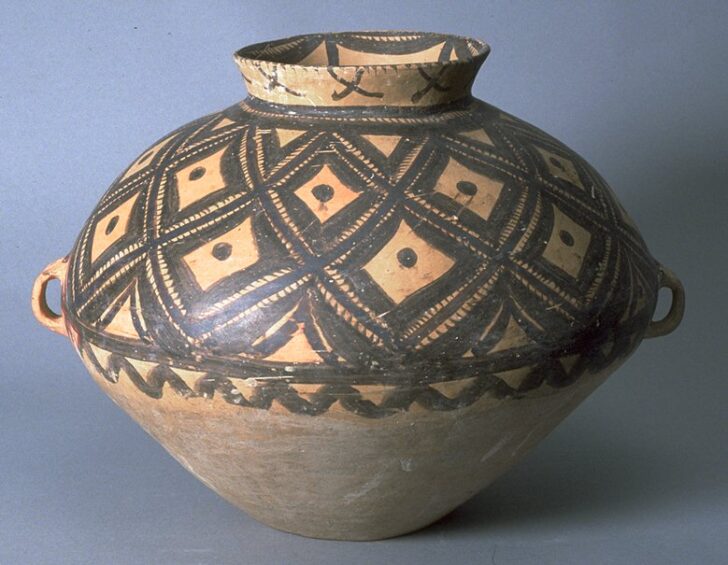Jar
Chinese

Description
Subject Matter:
This item is a mortuary urn or guan (罐) jar of the Neolithic Banshan phase (2600 BCE-2300 BCE) of Majiayao Culture from Banshan, Gansu of the Yellow River Valley. Discovered by Johan Gunnar Andersson in 1921, by the 1980s approximately 60,000 items and 400 kilns had been discovered at Majiayao sites (He Li 1996, 22). They were found in subterranean graves with conical bases placed into the local soil, and because the decoration is consistent only on the top portion of the jar, it can be assumed they were meant to be viewed from above. Rhomboid decorations such as this are among the eight most common decorations on guan found at the Banshan site. While it is impossible to know the meaning behind this decoration, researchers suggest perhaps this pattern represents fishing nets, a major source of food supplied by the Yellow River. The two lug handles were probably used to tie down a wooden, or other decomposable material, lid. An abundance of this type of guan were made with similar proportions, which suggests the use of a mathematical module, standardization, assembly line style mass production and the possible division of labor during the Neolithic period (Poor 1995, 166).
References:
He, Li. Chinese Ceramics: a New Comprehensive Survey From the Asian Art Museum of San Francisco. New York: Rizzoli, 1996.
Poor, Robert. "The Circle and the Square: Measure and Ritual in Ancient China" Monument Serica 43 (1995), 159-210.
Physical Description:
This light reddish-buff earthenware guan (罐) jar has a wide globular upper body and a conical lower body on a narrow flat base with a narrow neck and flaring rim. There are two diametrically opposed lug handles at the waist. Painted on the upper half of the body with black pigment are a network of rhomboid shapes, hatch-marks and dots confined within solid band borders, with a lobed line border below. Around the neck are a painted "X" design, hatch marks and a lobed border to the interior.
Usage Rights:
If you are interested in using an image for a publication, please visit https://umma.umich.edu/request-image/ for more information and to fill out the online Image Rights and Reproductions Request Form.